Exploring Japan’s Iconic Festivals
Japan’s traditional festivals, known as “matsuri,” are a vibrant and integral part of the country’s cultural heritage. These festivals, often dating back centuries, are celebrated with great enthusiasm and are deeply rooted in local customs and traditions. Among the numerous festivals celebrated across Japan, the Gion Festival in Kyoto and the Nebuta Festival in Aomori stand out for their grandeur, historical significance, and unique charm. Additionally, festivals like the Awa Odori in Tokushima, Kanda Matsuri in Tokyo, and Kanto Festival in Akita add to the rich tapestry of Japanese celebrations. Let’s delve into the history, highlights, and attractions of these iconic festivals.
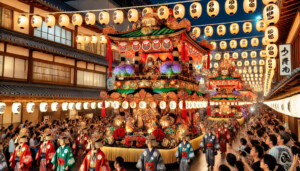
Gion Festival: A Celebration of Kyoto’s Spirit
The Gion Festival (祇園祭, Gion Matsuri) is one of Japan’s most famous and oldest festivals, held annually in Kyoto during the entire month of July. It originated in 869 AD as a religious ceremony to appease the gods during a plague outbreak. Over the centuries, it has evolved into a grand celebration, showcasing the rich cultural heritage of Kyoto.
Historical Background
The festival’s history dates back over a thousand years when it began as a purification ritual to eradicate epidemics. The people of Kyoto prayed to the deity Gozu Tennō to protect them from disease and disaster. Since then, the festival has grown in scale and significance, becoming an annual event that attracts millions of visitors from around the world.
Highlights of the Gion Festival
1. Yamaboko Junko (Procession of Floats): The highlight of the Gion Festival is the Yamaboko Junko, the grand procession of elaborately decorated floats known as “yama” and “hoko.” These floats, towering up to 25 meters and weighing several tons, are pulled through the streets of Kyoto on July 17th and 24th. Each float is a work of art, adorned with intricate tapestries, wooden carvings, and beautiful decorations. The parade is accompanied by traditional music, adding to the festive atmosphere.
2. Yoiyama Evenings: In the days leading up to the main procession, the streets of downtown Kyoto are transformed into a lively festival ground. During the “Yoiyama” evenings, from July 14th to 16th and 21st to 23rd, the floats are lit up, and visitors can walk around to admire their beauty up close. Stalls selling traditional food, drinks, and souvenirs line the streets, creating a festive and convivial atmosphere.
3. Mikoshi Togyo (Portable Shrine Procession): Another significant event is the Mikoshi Togyo, where portable shrines (mikoshi) carrying the deities are paraded through the city. This procession, held on July 17th, is believed to transfer the divine spirits from Yasaka Shrine to the floats, ensuring their protection and blessing.
4. Traditional Performances: Throughout the festival, various traditional performances, including Noh and Kyogen theater, tea ceremonies, and ikebana (flower arranging) exhibitions, are held at different venues. These performances offer a glimpse into Japan’s rich cultural traditions and artistic heritage.
5. Gion Bayashi (Festival Music): The traditional festival music, known as Gion Bayashi, is an integral part of the Gion Festival. Played on flutes, drums, and bells, the music accompanies the float processions and adds a festive and spiritual atmosphere to the celebrations. The melodies have been passed down through generations and are instantly recognizable to those familiar with the festival.
Image of the Gion Festival
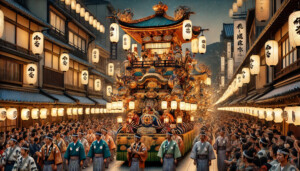
Nebuta Festival: A Night of Illuminated Splendor
The Nebuta Festival (ねぶた祭り, Nebuta Matsuri) in Aomori is another spectacular festival that takes place from August 2nd to 7th each year. Known for its stunning illuminated floats and energetic parades, the Nebuta Festival is a celebration of light, color, and music.
Historical Background
The origins of the Nebuta Festival are not precisely known, but it is believed to have roots in the Tanabata Festival, which was introduced to Japan from China in the 8th century. The festival evolved over the years, incorporating local customs and traditions. Today, it is one of the largest and most famous festivals in northern Japan.
Highlights of the Nebuta Festival
1. Nebuta Floats: The centerpiece of the festival is the magnificent Nebuta floats, which are large, illuminated paper lanterns depicting historical and mythical figures, warriors, and kabuki actors. These floats, some as tall as 9 meters and as wide as 5 meters, are made of painted washi paper over wire frames and lit from within by hundreds of light bulbs. The craftsmanship and artistic detail of these floats are truly awe-inspiring.
2. Haneto Dancers: Accompanying the floats are the lively “haneto” dancers, dressed in colorful costumes and bells. The dancers, chanting “Rassera, Rassera,” move energetically along the parade route, encouraging spectators to join in the festivities. The infectious energy and rhythmic dance steps create a joyous and vibrant atmosphere.
3. Night Parades: The Nebuta floats are paraded through the streets of Aomori during the evening parades, from August 2nd to 6th. The illuminated floats, accompanied by the rhythmic beat of taiko drums and traditional flutes, create a mesmerizing spectacle against the night sky. The grand finale on August 7th features a daytime parade followed by a stunning fireworks display over Aomori Bay.
4. Festival Markets: The festival atmosphere extends beyond the parades, with numerous market stalls offering local delicacies, festival foods, and souvenirs. Visitors can enjoy Aomori’s famous apples, fresh seafood, and traditional snacks while soaking in the festive spirit.
Image of the Nebuta Festival
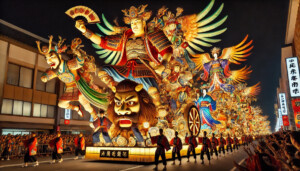
Kanto Festival: A Display of Skill and Balance in Akita
The Kanto Festival (竿燈祭り, Kanto Matsuri) is one of the most unique and visually striking festivals in Japan, held annually from August 3rd to 6th in Akita City. Known for its impressive displays of skill and balance, the Kanto Festival features long bamboo poles decorated with paper lanterns.
Historical Background
The Kanto Festival has its origins in ancient rituals to pray for a good harvest and drive away evil spirits. It is believed to have evolved during the Edo period, with records indicating its existence as early as the 18th century. Today, the festival is celebrated to showcase the region’s cultural heritage and attract visitors from across Japan and the world.
Highlights of the Kanto Festival
1. Kanto Performances: The main attraction of the Kanto Festival is the performance of balancing kanto poles, which can reach up to 12 meters in height and weigh around 50 kilograms. The poles are adorned with numerous paper lanterns, each representing a grain of rice, symbolizing the harvest. Performers balance these poles on their palms, foreheads, shoulders, and backs, showcasing incredible skill and balance.
2. Night Parades: Each evening, the streets of Akita City are filled with performers carrying the illuminated kanto poles, creating a breathtaking sight. The lanterns glow warmly against the night sky, and the rhythmic chants of “Dokkoisho, Dokkoisho” resonate through the air as performers demonstrate their balancing prowess. Spectators can walk among the performers and even try their hand at balancing a kanto pole under supervision.
3. Daytime Events: During the day, various events and activities are held, including kanto competitions, traditional music and dance performances, and workshops where visitors can learn more about the festival and its history. There are also markets offering local foods, crafts, and souvenirs.
4. Festival Spirit: The Kanto Festival is not just a display of physical skill but also a celebration of community spirit. Local neighborhoods and organizations participate with their own kanto teams, fostering a sense of pride and unity. The festival atmosphere is welcoming and inclusive, encouraging visitors to join in the celebrations.
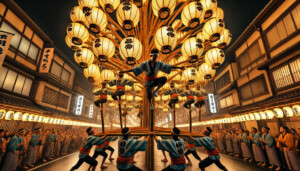
Awa Odori: Dance of Joy in Tokushima
The Awa Odori (阿波おどり) is one of Japan’s largest and most famous dance festivals, held annually in Tokushima Prefecture on Shikoku Island from August 12th to 15th. Known for its lively and joyous atmosphere, the Awa Odori attracts over a million visitors each year.
Historical Background
The origins of the Awa Odori date back to the late 16th century when the lord of Tokushima held a grand celebration to mark the completion of Tokushima Castle. The celebrations included dancing, singing, and drinking, which evolved into the modern Awa Odori. The festival’s name “Awa” refers to the old province of Tokushima, and “Odori” means dance.
Highlights of the Awa Odori
1. Dance Processions: The heart of the Awa Odori is the dance processions, where groups of dancers, known as “ren,” parade through the streets performing a distinctive dance. The dancers move in a lively and rhythmic manner, accompanied by traditional music played on shamisen, taiko drums, and flutes. The dance is characterized by its energetic steps and the chant of “Yattosa, Yattosa.”
2. Costumes: Dancers wear traditional costumes, with men donning happi coats and straw hats, and women wearing yukata and sedge hats. The colorful costumes add to the visual spectacle and create a vibrant and festive atmosphere.
3. Audience Participation: The Awa Odori encourages audience participation, and visitors are often invited to join in the dancing. Special areas are designated for those who want to experience the dance firsthand, making it a truly inclusive and immersive festival.
4. Traditional Music: The music of the Awa Odori is an essential part of the festival, with its lively and rhythmic tunes setting the pace for the dancers. The combination of shamisen, taiko drums, and flutes creates a unique and infectious melody that resonates throughout the festival.
Kanda Matsuri: A Celebration of Edo’s Spirit in Tokyo
The Kanda Matsuri (神田祭) is one of Tokyo’s three major Shinto festivals, along with the Sanno Matsuri and the Fukagawa Matsuri. Held in mid-May in odd-numbered years, the Kanda Matsuri is a grand celebration that showcases the spirit and history of Edo (the old name for Tokyo).
Historical Background
The Kanda Matsuri dates back to the early 17th century when it was established to celebrate the victory of Tokugawa Ieyasu at the Battle of Sekigahara. The festival was held to honor the Kanda Myojin Shrine’s deities, who were believed to have played a role in the victory. Over the centuries, the Kanda Matsuri has evolved into a major event, symbolizing the prosperity and vitality of Tokyo.
Highlights of the Kanda Matsuri
1. Mikoshi Processions: The highlight of the Kanda Matsuri is the procession of mikoshi, portable shrines that are paraded through the streets of Tokyo. The mikoshi, adorned with gold and lacquer, are carried by enthusiastic participants who chant and sway the shrines to the rhythm of the music. The procession covers several kilometers and passes through key areas of Tokyo, including Kanda, Nihonbashi, and Akihabara.
2. Traditional Parades: In addition to the mikoshi processions, the Kanda Matsuri features a grand parade with participants dressed in traditional costumes. The parade includes floats, traditional music bands, and performances of martial arts and dances. The vibrant costumes and lively performances create a festive atmosphere and attract large crowds of spectators.
3. Shrine Rituals: Throughout the festival, various rituals and ceremonies are held at the Kanda Myojin Shrine. These include purification rites, prayers for prosperity, and performances of traditional music and dance. Visitors can witness these rituals and experience the spiritual aspect of the festival.
4. Festival Markets: Like other major festivals, the Kanda Matsuri features numerous market stalls selling traditional foods, drinks, and souvenirs. Visitors can enjoy a variety of Japanese street foods, such as yakitori, takoyaki, and taiyaki, while exploring the festival grounds.
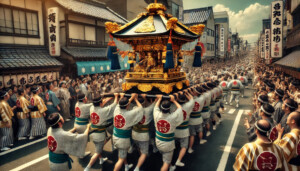
Tanabata Festival: The Star-Crossed Celebration
The Tanabata Festival (七夕祭り), also known as the Star Festival, is celebrated on July 7th across Japan. The festival is based on the legend of two star-crossed lovers, Orihime (Vega) and Hikoboshi (Altair), who are separated by the Milky Way and can only meet once a year on this day.
Historical Background
The origins of the Tanabata Festival can be traced back to the Chinese Qixi Festival, which was introduced to Japan during the Heian period. Over time, it merged with local Japanese customs and evolved into the Tanabata Festival. The festival is celebrated by writing wishes on colorful strips of paper (tanzaku) and hanging them on bamboo branches.
Highlights of the Tanabata Festival
1. Tanzaku Wishes: One of the main customs of the Tanabata Festival is writing wishes on tanzaku, small pieces of colored paper. People write their wishes for love, success, and happiness and hang them on bamboo branches. The bamboo branches, adorned with tanzaku, are often placed outside homes, schools, and businesses.
2. Decorations: The streets and public spaces are decorated with large, colorful streamers and ornaments made of paper and bamboo. These decorations represent the Milky Way and the meeting of Orihime and Hikoboshi. The vibrant and intricate decorations create a festive and magical atmosphere.
3. Festivals and Events: Various Tanabata festivals and events are held across Japan, with some of the most famous celebrations taking place in Sendai and Hiratsuka. These festivals feature parades, performances, and fireworks displays, attracting large crowds of visitors.
4. Traditional Food: During the Tanabata Festival, traditional foods such as somen (thin wheat noodles) are enjoyed. The long noodles symbolize the weaving threads of Orihime and are believed to bring good fortune.
Conclusion
The Gion Festival, Nebuta Festival, Kanto Festival, Awa Odori, Kanda Matsuri, and Tanabata Festival are just a few examples of the rich tapestry of traditional festivals that Japan has to offer. Each festival has its unique history, customs, and highlights, providing a fascinating glimpse into Japan’s cultural heritage. Whether you’re drawn to the elegant floats of the Gion Festival, the illuminated splendor of the Nebuta Festival, the impressive balance of the Kanto Festival, the lively dance of the Awa Odori, the grand processions of the Kanda Matsuri, or the starry magic of the Tanabata Festival, these celebrations offer unforgettable experiences. By participating in these festivals, you not only witness the beauty and artistry of Japanese culture but also become part of a centuries-old tradition that continues to thrive and enchant people from all over the world.
Comment